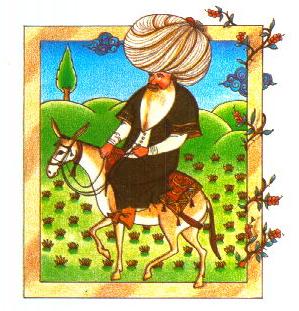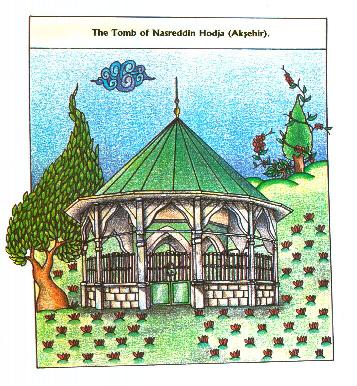

Nasreddin Hodja is a collection of Hodja stories compiled by Alpay Kabacali, beautifully illustrated by Fatih M. Durmus, and published by NET. It also contains a historical introduction to the stories (well, to the extent that anything historical can be written about the Hodja), and a bibliography. The rendition is a simple one, but the essence of Hodja humor is nicely captured, especially by the illustrations.
| Page 1 | Why Did He Ride On The Donkey Backwards? | 
|
| Page 2 |
Everyone Who Sees The Light Forty year Old Vinegar | |
| Page 3 | Mortal's Way | |
| Page 4 |
How A Donkey Reads! We Are Even | |
| Page 5 | Inexperienced Nightingale | |
| Page 6 |
No Need For So Much Fuss Should Have His Own Donkey | |
| Page 7 | What If It Happens | |
| Page 8 |
Let Them See Me Trading Thank God | |
| Page 9 | Female Calamity | |
| Page 10 |
Didn't Know How To Land Properly I Know What I'll Do Taste The Same | 
|
| Page 11 | Duck Soup | |
| Page 12 |
Earth's Balance If I Were On It If It Is Up To The Turban And The Robe | |
| Page 13 | Then, Where Is The Cat | |
| Page 14 |
Remembered It's Childhood Have It Pulled Out With This Huge Bowl | |
| Page 15 | Charge For Ten Days | |
| Page 16 |
Force You To Eat Not To Leave His Head To Climb Hills | |
| Page 17 | A Pan Of Baklava | |
| Page 18 | The Quilt Is Gone And The Fight Is Over | |
| Page 19 |
Look What You Gave Eat, My Fur Coat, Eat! | |
| Page 20 |
Tried Hard But... Such Big Mistakes I Was In It | |
| Page 21 |
Let Us Die, Too Run to The Lake Out Of Embarrasament | |
| Page 22 | Those Who Know Teach | |
| Page 23 |
Settle For Nine Cash Money Make Stars | |
| Page 24 | Just An Ordinary ... | |
| Page 25 |
If The Angel Of Death Comes Center Of The Earth | |
| Page 26 | Smoke Seller | |
| Page 27 |
What's Keeping You It Is Dark In There | |
| Page 28 | The Broth Of The Broth | |
| Page 29 | Who Needs The Soap More! | |
| Page 30 |
With The Luck You Brought The Feeling Of Finding | |
| Page 31 | Then You'll See | |
| Page 32 |
Who Is Going To Sell The Pickles? Look Like A Bird Funeral Is Coming To Our House | |
| Page 33 | I Will Never Mingle Into Your Affairs | |
| Page 34 |
Was Just Getting Used To Was Going To Get Down Anyway Every Time I Got On | |
| Page 35 | Either You Have Never Been Whipped | |
| Page 36 |
Hear It Tomorrow You Take The Money | |
| Page 37 | Don't Have It | |
| Page 38 |
Follow This Road Did He Have A Head? | |
| Page 39 | By The Light Of An Oil Lamp | |
| Page 40 | Something Is Wrong With The Honey | |
| Page 41 |
Don't Bother The Wolf How Far After The Damage Is Done | |
| Page 42 |
In Three Years Time Haven't We Moved If The Wrong Is Not Known | |
| Page 43 |
Use As Weights Know How To Swim | |
| Page 44 | One Who Gives The Money | |
| Page 45 |
Need A Rooster If I Were In It | |
| Page 46 | Where It Belongs | |
| Page 47 |
My Legs Shook Haven't We Moved Shall I Move More | |
| Page 48 | Dead Owner | |
| Page 49 |
No Change Third Year Not Even Getting Down | |
| Page 50 | You Believe The Donkey | |
| Page 51 | This One Thinks | |
| Page 52 |
From The Other World Sound Asleep | |
| Page 53 | I Have The Recipe | |
| Page 54 |
You Were Different Only Those Who Sleep On Roof Tops | |
| Page 55 | Money For Trousers | |
| Page 56 | Mules Carrying Pots And Pans | |
| Page 57 | Innocent Thief | |
| Page 58 |
49th Of Ramadan Whoever Has The Blue Bead | |
| Page 59 | If It Wears These | |
| Page 60 |
Why He Coughed It Doesn't Make Any Difference When You Were Young | |
| Page 61 | Do As You Please | |
| Page 62 |
It Is Better Wherever It Takes Me Be A Kite For A Year I Felt Sorry | |
| Page 63 | You Believed That lt Gave Birth | |
| Page 64 |
Behind The Mountain Can Smell Fantasies Turn Inside Out | |
| Page 65 | None Of Your Business | |
| Page 66 |
Flour On The Rope I Did Not Like It Either Mysterious Ways |
Back to top of page
Back to Jeremy Schiff's Hodja homepage
Back to Jeremy Schiff's personal homepage
Introduction
Wit, common sense, ingenuousness, ridicule... and the kind of humor
that reflects human psychology, exposes the shortcomings of a society,
criticizes even state and religious affairs yet always settles matters
amicably are the elements which together create a special kind of logic,
the Nasreddin Hodja logic. These features of the stories make the 13th
century character Nasreddin Hodja immortal. Therefore, it is not an
exaggeration to consider him one of the main building blocks of folk
thought, and his humor, one of the best in the world.
Yet, it should be pointed out that these stories are related neither to Nasreddin Hodia himself nor to his historical personality. In other words, over the centuries many new stories where he was used as the main character have emerged, enriching the collection we have today. According to certain stories, Hodja was a contemporary of Tamerlane, who invaded Anatolia at the beginning of the 15th century, and according to the others, he lived either before or after the age of Tamerlane. Today, we still do not have historical documents that relate Hodja's life and his personality in depth.
The date 386 found inscribed on a gravestone attracted a lot of attention. Considering his humor, the date was read backwards. The year 683 of the Islamic calendar corresponds to the years 1284-1285. Other documents were used to support the theory that he died sometime in the years 1284-1285. One of the most reliable document is the date 1383 (796 in the Islamic calendar) found inscribed on the wall of his tomb in Aksehir. It indicates that Hodja died before 1393 and his tomb had been visited for years.
The town of Sivrihisar of the city of Eskisehir is accepted as the birthplace of Hodja. A gravestone dated 1327 found in Sivrihisar, belongs to his daughter Fatima and indicates that she lived 43 more years after his death.
The oldest Nasreddin Hodja story is found in the book called "Saltukname" written in 1480, which also contains other folk stories and legends. It is stated in "Saltukname" that Hodja was born in Sivrihisar and that the natives of Sivrihisar were famous for their strange behavior and ingenousness. The strange behavior of the natives of Sivrihisar is also mentioned in a handwritten story book in Biblioteque Nationale in Paris. These documents are considered proof of his birth in Sivrihisar.
Based on the above mentioned documents and certain stories, following is the life story of Nasreddin Hodja:
He was born in the village of Hortu of Sivrihisar and died in 1284 in Aksehir, a province of Konya, where his tomb is. His father was the imam (religious leader) of the village. Hodja, himself, too, served as the imam of the village for a period of time and later went to Aksehir to become the dervish of the two very famous Islamic mystics of the time. In his life time he also served as a judge and university professor.
As mentioned before, according to certain sources, he was a contemporary of Tamerlane, who invaded Anatolia in 1301, but according to the others a person named Nasreddin Hodja never lived; he was just an imaginary character in the folk stories.
It is obvious that Hodja was a witty man with a sense of humor and he was a good conversationalist. Yet, based on most of the stories it is wrong to assume that everything he said was humorous. Over the years, the number of Nasreddin Hodja stories increased significantly since he was used as the main character in the new stories about other people. Among these, there are some that are easily recognized as not authentic Nasreddin Hodja stories. We can, therefore, say that Hodja and his stories were created by the natives of Anatolia in the 13th century, and the creation has lasted for centuries. Today, these stories belong to all Turkish people.
The themes of the stories cover not just the age when Nasreddin Hodja lived but also the adventures of Turkish people over the centuries. As one of our writers said "Nasreddin Hodja is the only person who lived both before his birth and after his death. There are many historical and social personalities who kept on living after their death but the only person on earth who lived before his birth is Nasreddin Hodja." Therefore, social life, the shortcomings of social life, differences between the ruling class and the common people, famines, the thousand faces of daily life, man to man, man to object, man to animal relations are the different themes of the stories and in all of these stories Nasreddin Hodja is a symbol.
Nasreddin Hodja stories were spread by word of mouth over a vast area mainly in the lands under the domain of the Ottoman Empire and the lands where Turkish was spoken. In certain countries, the Hodja character was almost his "twin brother" or a "competitor", and it other countries only the name Nasreddin Hodja was modified in the stories. Today, Nasreddin Hodja stories are told in a vast geographic area extending from East Turkmenistan to Hungary and from Southern Siberia to North Africa. The stories have been translated into many languages.
The new Nasreddin Hodja stories that emerge and the old ones that are adapted prove that these stories are immortal. On the other hand, it is stated that since these stories, products of the imagination of common people, are adaptable it is natural that they are updated in each generation and that is why Nasreddin Hodja is still the most popular story character in Turkey. In other words, as light attracts moths, Nasreddin Hodja character attracts new stories.
Nasreddin Hodja stories are told in such succinct phrases that the last phrase of the stories which is uttered by Hodja have become popular epigrams or sayings like "laying flour on rope," "making it look like a bird," "the quilt is gone, the fight is over," "cutting the branch one is sitting on," etc.
Every year, between July 5-10, International Nasreddin Hodja Festival is organized in Aksehir where his tomb is. To keep Hodja character alive, Turkish writers and artists have used it in drama, in music, in movies (especially cartoons), in comic strips, in paintings.
After reading the stories in this book, we think that you, too, will believe that Hodja will be living for generations to come. Just as Hodja did, may be you, too, will answer when asked "What do they do with the old full moons?", "They cut them up into small pieces and make stars!.."
Even in this Space Age!..
Back to top of page
Back to Jeremy Schiff's Hodja homepage
Back to Jeremy Schiff's personal homepage
Back to top of page
Back to Jeremy Schiff's Hodja homepage
Back to Jeremy Schiff's personal homepage